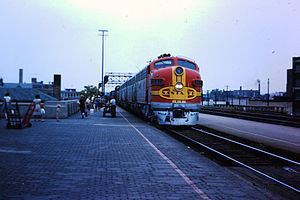 | ||
1936 santa fe grand canyon limited san bdno ca
The Grand Canyon Limited was one of the named passenger trains of the Atchison, Topeka and Santa Fe Railway. It was train Nos. 23 & 24 between Chicago, Illinois, and Los Angeles, California.
Contents
- 1936 santa fe grand canyon limited san bdno ca
- Grand canyon limited and gcr s regular train departing williams az
- History
- Timeline
- Equipment used
- References
Grand canyon limited and gcr s regular train departing williams az
History
In 1901 the Santa Fe Railroad completed a 64-mile (103-km) branch from Williams, Arizona, to "Grand Canyon Village" at the South Rim of Grand Canyon National Park. The first scheduled train arrived from Williams on September 17 of that year; branch line trains and excursions from Southern California, Chicago, and Texas could run directly to the Rim. On June 29, 1929 service commenced on the Grand Canyon Limited, which became a celebrated vacation train.
The westward train split at Barstow, one section running to San Francisco (Oakland-Richmond) via the Tehachapi Loop while the other continued to Los Angeles. In 1938 it began running via Amarillo instead of La Junta; in 1950 it became two trains west of Kansas City, one by each route.
During World War II the Limited often ran in two or three sections carrying troops. In later years the train lost passengers to the railroad's newer trains such as the Super Chief with its streamlined cars.
The Grand Canyon train lost its name in early 1968 when the railway petitioned the ICC to drop service to Grand Canyon National Park; the train would continue as Trains 23 and 24 until the May 1, 1971 handover of all passenger service to Amtrak.
Timeline
Equipment used
A variety of steam- and diesel-powered locomotives pulled the Grand Canyon Limited.
The original rolling stock delivered for the second-class Grand Canyon Limited was heavyweight cars built by Pullman-Standard.
Train length varied; the train often ran in two or three sections during the summer months.
Near the end of its career, in 1968, a typical consist between Chicago and Kansas City was:
